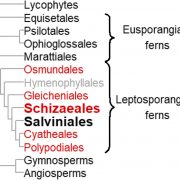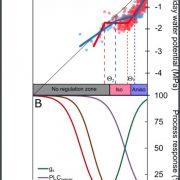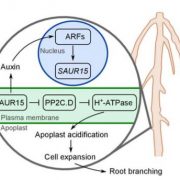
On the Inside: Altered Alternative Splicing in Virus-Infected Plants
Plant Physiology, Plant Physiology: On The Inside
Viruses have small genomes with limited protein-coding capacities. To compensate for this, viruses modulate plant gene expression and co-opt host factors to support their replication, cell-to-cell movement, and systemic movement. Modulation of host gene expression can lead to the development of disease…

On the Inside: Blue Light Sensitivity in One Order of Ferns
Plant Physiology, Plant Physiology: On The InsideStomata respond to changes in the light environment through multiple mechanisms that jointly regulate the tradeoff between carbon assimilation and water loss. The rapid and highly sensitive widening of stomatal aperture in response to low-fluence blue light is present in most vascular plant groups but…

Extrapolating physiological response to drought through step-by-step analysis of water potential
Blog, Plant Physiology, Plant Physiology: News and Views, ResearchGuillaume Charrier
Université Clermont Auvergne, INRAE, PIAF, F-63000 Clermont-Ferrand, France.
[email protected]
Water potential (Ψ) defines the energy required to move water between the different compartments of a closed system. Water flows passively in the direction of decreasing…

SAUR15 connects auxin perception to lateral and adventitious root formation
Blog, Plant Physiology, Plant Physiology: News and Views, ResearchCharles Copeland1
1Department of Plant Microbe Interactions, Max Planck Institute for Plant Breeding Research, 50829 Cologne, Germany
ORCID: 0000-0001-8535-8615
[email protected]
As plants grow, they produce new organs such as leaves, lateral roots, and flowers. Plant development…

Recognizing Plant Physiology authors: Maria Betsabe Mantilla-Perez
Plant Physiology, Plant Physiology: Author ProfilesMaria Betsabe Mantilla-Perez, first author of Towards "smart canopy" sorghum: discovery of the genetic control of leaf angle across layers
Current Position: Principal Wheat Breeder at Bayer Crop Science, USA
Non-Scientific Interest: travelling, dancing, and outdoor activities.
Brief Bio: I am…

Barley RIPb opens the gates for epidermal fungal penetration
Blog, Plant Physiology, Plant Physiology: News and Views, ResearchElisa Dell’Aglio
Institut National des Sciences Appliquées de Lyon
Lyon,
France
[email protected]
The ascomycete Blumeria graminis f. sp. hordei (Bgh) is a powdery mildew causal agent, specifically adapted to barley (Hordeum vulgare), wheat (Triticum aestivum, Triticum turgidum)…

Lignification and oxidative enzymes: Localization, localization, localization!
Blog, Plant Physiology, Plant Physiology: News and Views, ResearchName Marc Somssich
Affiliation University of Melbourne
ORCiD 0000-0001-5092-6168
[email protected]
Lignification of cell walls is a pivotal process in plant life. Lignin is a biopolymer that provides additional stability to secondary cell walls (SCWs), enables vascular cells to…

MYB30 links the ROS wave to systemic acclimation
Blog, Plant Physiology, Plant Physiology: News and Views, ResearchAmna Mhamdi
Ghent University, Department of Plant Biotechnology and Bioinformatics, and VIB Center for Plant Systems Biology, 9052 Ghent, Belgium
Address correspondence to [email protected]
Stress signals trigger systemic signaling and acclimation. The propagation of reactive oxygen species…

Unexpected Role of a TCP Transcription Factor in Seed Oil Biosynthesis
Blog, Plant Physiology, Plant Physiology: News and Views, ResearchTianhu Sun
ORCID ID: 0000-0002-2513-1387
Plant Breeding and Genetics Section, School of Integrative Plant Science, Cornell University, Ithaca, New York 14853
[email protected]
Plant seed oils (such as canola oil, sunflower oil, and soybean oil) are important for the human diet and store energy…

